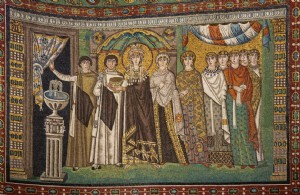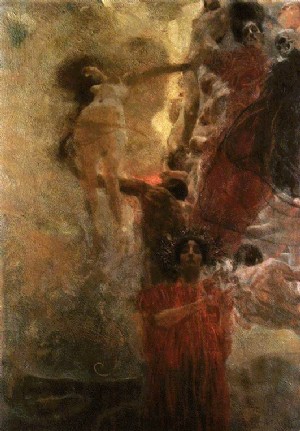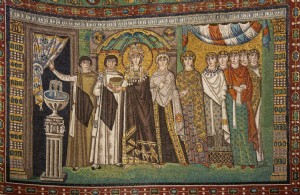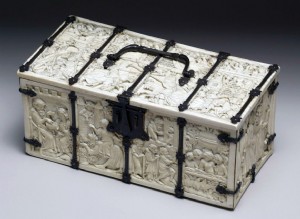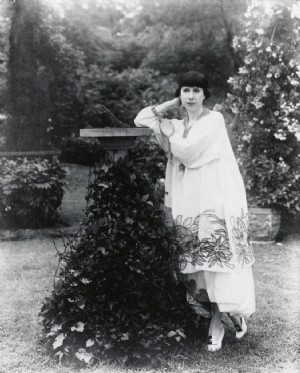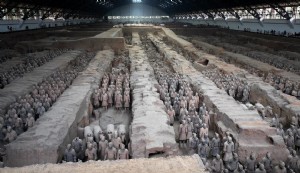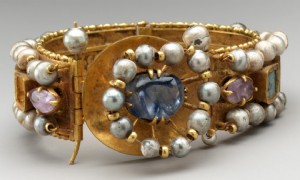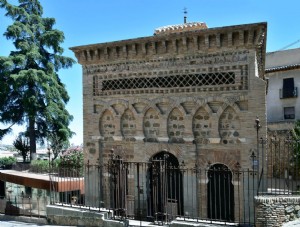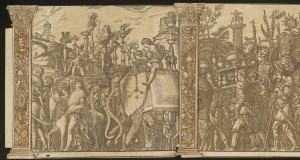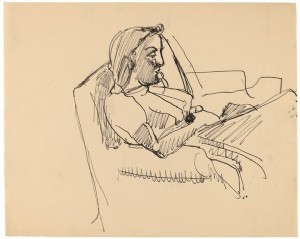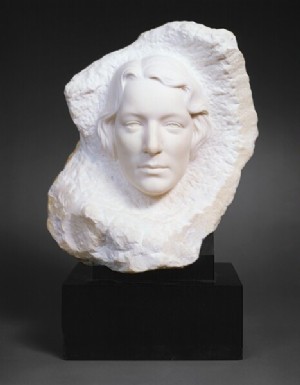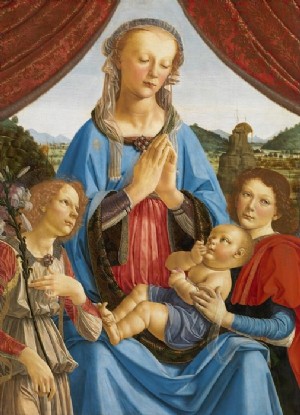시대를 앞서간 많은 천재들처럼 앙리 루소는 평생 알지 못했는데, 명성도 부도 아닙니다. 재능있는 아티스트, 41세까지 파리 세관에서 일반 사무원으로 일하며, 평소 생활 방식을 포기하고 그림에 전념할 의지를 찾았습니다. 취미로 루소를 지지한 유일한 것은 자신의 재능에 대한 흔들리지 않는 믿음이었습니다. 그로 인해 그는 당대의 가장 위대한 거장 중 한 명이 되었습니다. 놀랍게도, 과거의 기술을 모방하려는 욕망은 예술가를 미래로 직접 옮겼습니다. 그의 창조적 인 방식은 XX 세기의 많은 주인의 특징이 될 것입니다. Russo의 "순진한"예술, 인상주의에 발맞추어 곧 완전히 다른 학교로 분리됩니다. 화가의 원래 스타일, 판타스마고리아의 요소가 가득, 파블로 피카소와 로베르 들로네가 존경하는 Rousseau는 자신의 생애 동안 최소한의 생계 수단만을 제공했습니다.
폭풍우 치는 젊음
마흔한 살에 예술가로서의 경력을 시작하고, Henri Russo는 독학했습니다. 파리 지방에서 도착하여 하급관료로 정착하여 도처에 그린 루소:근무 중 근무 중, 상사의 호의를 이용하여 그리고 밤에 집에서. 가난한, 하지만 인내심, 보통의, 그러나 그의 천재성에 대한 확신, 그는 예술적 아방가르드의 선도적이고 가장 인정받는 거장 중 한 명이 되었습니다. 진보적인 동시대인들과 후손들에게 존경을 받았습니다.
루소 자신이 "다음 세기의 초상화"라는 책에 대한 자전적 메모를 쓴 적이 있습니다. 그는 잘못된 직업에 전념해야 했습니다. 그의 예술에 대한 사랑으로 그를 매료시켰습니다.” 진실, 책은 나오지 않았다.
독학 예술가의 아버지는 Julien Russo였습니다. Julien Russo는 프랑스 서부의 Laval 마을에서 온 유전적인 양철 세공인이었습니다. 그리고 그의 어머니는 나폴레옹 대군 장교의 딸입니다. 앙리의 아버지는 부자가 되고 싶었지만, 그러므로, 도시 외곽에 집을 샀고, 그는 자신의 공예를 양철공으로 남겨두고 다양한 상품을 재판매하는 사업을 시작하려고 합니다. 하지만, 아아, 그의 작품은 불타고, 그 이후로 절망적인 빈곤이 Russo의 집에 정착했습니다.
다행스럽게도, 극단적인 필요에도 불구하고, 미래 예술가의 가족은 그녀의 외아들을 학교에서 먼저 공부하도록 보낼 수 있었고, 그리고 Lyceum에서. 앙리는 평범한 학생이었고, 비록 그는 많은 학교 상을 수상했지만, 노래와 산수에서 자신을 구별합니다. 이러한 겉보기에 사소해 보이는 업적은 루소가 세계적으로 유명한 예술가가 되었기 때문이 아니라 그의 전기에서 도처에 기록되어 있습니다. 그러나 그는 또한 그의 첫 번째 아내의 이름을 딴 놀라운 왈츠인 "Clemence"를 작곡했기 때문입니다.
훈련 후, 헨리는 법률 사무소에 취직하고, 그가 큰 실수를 하는 곳. 열아홉 살 때, 친구들의 권유로, Rousseau는 회계 부서에서 약간의 돈을 훔치고, 그러나 이것은 그의 변호사 경력을 끝내고 조사를 받기에 충분합니다. 법정에서, 헨리는 계약에 동의해야 합니다. 최대 7년의 군 복무, 징역 1년만.
루소 연대, 프랑스에 주둔하고, 해외 적대 행위에 결코 가담하지 않을 것입니다. 나폴레옹 3세가 제국의 왕위를 다투는 그의 제자 막시밀리안을 지원하기 위해 프랑스군을 멕시코로 파견할 때도, 미래 전위는 원정에 참여하지 않습니다. 하지만, 훨씬 나중에, 시인 기욤 아폴리네르(Guillaume Apollinaire, 1880 - 1918)는 다채로운 아즈텍 국가에서 루소의 체류에 관한 시를 씁니다. 예술가는 결코 그것을 반박하려 하지 않는다. 그의 삶에 대한 다른 많은 신화뿐만 아니라.
1868년, 루소의 아버지가 죽고, 그리고 헨리, 가족의 유일한 가장으로서, 군대에서 해고를 당합니다. 그의 연대를 떠난 후, 당시 파리에 있던 그는 대도시의 바쁜 생활 속으로 뛰어듭니다. 가장 먼저, 청년은 일자리를 찾아 목숨을 끊고, 봉마르쉐에서 멀지 않은 곳에 위치한 프랑스 수도 최초의 다층 쇼핑 센터.
청년은 즉시 그 집 여주인의 딸과 사랑에 빠지고, 부타르 부인. 1869년, 그는 Clemence Buatar를 아내로 받아들입니다. 계속되는 약점에도 불구하고(클레망스는 결핵에 걸렸다), 배우자는 Henri가 평생 돈을 벌도록 도와줍니다. 주문에 따라 쉬지 않고 바느질을 한다. 주말에, 연인들은 종종 아름다운 파리 공원을 걷습니다. 진실, Henri와 Clemence의 행복은 그들의 아이들이 유아기에 잇달아 죽는 사실에 의해 가려집니다.
사랑하는 배우자의 일곱 자녀 중, Julie-Clemence의 딸과 Henri-Anatole의 아들 두 명만 살아남습니다. 루소의 아내, 끊임없이 결핵에 시달린다. 아이들을 스스로 돌보기에는 너무 약했고, 그래서 그들은 태어날 때부터 파리 교외에 살았던 유모에 의해 자랐습니다. 1888년, 클레멘스가 죽습니다. 앙리 루소는 사랑하는 아내를 결코 잊지 않을 것입니다. 그녀가 살아 있는 동안에도, 그는 그녀에게 자신이 작곡한 왈츠를 바칠 것입니다. 그리고 그녀가 죽은 후에 그는 계속해서 그녀의 초상화를 만들 것입니다.
사소한 공적 생활 예술
1871년, 젊은 Russo는 Excise Department의 세관에서 정규직을 얻었고, 19세기에 파리로 수입된 물품에서 세금을 징수했습니다. 성문에서 물건을 검사하는 것은 지루하고 단조로운 직업이며, 그러나 그것은 그것을 수행하는 사람의 내적 자유를 제한하지 않습니다.
다음 교대 중 하나 동안, 작은 점원이 백화점 건물 마당에 바로 이젤을 세우고, 그리고 그리기 시작합니다. 안타깝게도, 1877년까지 Russo가 그린 그림은 살아남지 못했습니다. 예외는 단 하나, 지역 풍경을 배경으로 전투 장면을 묘사합니다.
곧, 당시 유명한 예술가 Felix Clement(1826-1888), 젊은 Russo를 조언으로 도운 사람, 화가 지망생을 그 시대의 프랑스 공식 미술의 대표자 중 한 명에게 소개하고, 남작 레온 제롬. 이후, 루소는 그의 첫 번째 작업장을 임대했고 1885년, 남작이 지원하는 Les Miserables의 살롱에서 그의 두 작품을 처음 전시했습니다.
1년 후, 1886년, 예술가 폴 시냑(1863-1935), Henri Russo의 작품에 관심을 갖고, 새로운 전시회에 그를 초대합니다. 시냐크는 이런 원화가의 작품을 가장 잘 볼 수 있는 곳이 독립예술가의 살롱이라고 생각했고, 전위 예술의 대표자들에 의해 만들어졌습니다. 사실은 독립적 인 살롱을 만들려는 모든 초기 시도가 마치 마술처럼 실패로 끝났다는 것입니다. 그들은 공식 살롱을 닮기 시작했고, 별도로 전시해야 할 필요성을 느끼는 진보적인 화가들에게는 어울리지 않았다.
루소에게, 살롱이 대표하는 공식 미술계는 분명했고, 오랜 학문적 전통으로 독학을 영원히 거부했을 것입니다. 적어도 원칙에서. 그러므로, 그때부터 끝까지, Henri Russo는 새로운 "배심원 없는 살롱"에 충실할 것입니다.
이미 1886년, 독립 살롱에서 4점의 작품을 전시하고, 예술가 지망생은 Paul Gauguin(1848-1903)과 Puvi de Chavannes(1824-1898)와 같은 유명한 화가들에게 높이 평가될 것입니다. 그는 Rousseau가 다양한 검은색 음영의 도움으로 극적인 순간을 전달하는 능력에 기뻐했습니다. 하지만, 일반적으로, 그의 작품은 대중에게 이해되지 않고, 더군다나 조롱을 당하는 학자들은 어린아이도 그렇게 그릴 수 있다고 주장합니다.
다행스럽게도, Rousseau는 풍자와 대중의 비판에 매우 저항했습니다. 그는 심지어 Argus와 계약을 체결하고, 그에 따르면 모든 저널 기사와 신문 스크랩이 그에게 보내졌습니다. 그의 작품에 대한 리뷰와 논평이 포함되어 있습니다. 그의 탁월한 재능에 대한 보편적인 인정을 기대하며, 작가는 그것들을 노트에 현학적으로 붙였습니다. 결국 더 두꺼워진 것. 루소는 파리 시청이 그에게 메달을 수여했다는 소식을 신문에서 알게 됩니다. 행복하다, 그는 즉시 명함에 상을 언급하도록 명령합니다. 그러나 나중에 그가 서두르고 있다는 것이 밝혀졌습니다. 그것은 같은 이름을 가진 다른 예술가에 관한 것이었습니다.
아내가 죽은 후 아이들의 정상적인 양육을 위한 자금을 찾고 페인트를 구입한 후 걱정되는, 루소, 돈을 벌고 1889년 파리 만국박람회에서 감명을 받으며 프랑스가 그녀의 유명한 에펠탑을 선보인 곳, 예술가는 다시 음악으로 방향을 틀고 보드빌의 대본을 씁니다. 안타깝게도, 한 푼도 가져오지 않았습니다.
1893년 퇴역 후, 수년간의 서비스 후, 루소는 적은 연금을 받고 그가 가장 좋아하는 취미인 그림, 마침내 적당한 수입을 가져오기 시작할 것입니다. 그동안, 루소는 어쩔 수 없이 바이올린 레슨을 하고 주문에 따라 그림을 그려야 하고, 말도 안되는 가격에 판매합니다. 하지만, 불과 1년 후, 그의 작품 "전쟁", Salon of Independents에 전시된 폭넓은 반응을 얻고, 특히, 작가 Alfred Jary(1873-1907)는 그녀를 존경합니다. 누구의 빛으로, 예술가 Henri Russo는 "세관원"(Le Douanier)이라는 별명을 받고, 그에게 평생 고정.
곧, Russo 가족 전체가 이사하고, 누가 어디있어. 1895년, 화가의 딸은 남편과 함께 앙제로 떠나고, 프랑스 서부에 위치한 화가는 아들 앙리 아나톨레와 함께 센 강 좌안의 유명한 지역인 몽파르나스로 이사한다. 나중에 예술적이고 지적인 전위 예술가들이 가장 좋아하는 만남의 장소가 되었습니다. 거기, 몽파르나스에서, 루소는 화가의 마음을 사로잡은 동네에 사는 여성 조세핀 르 텐소러를 만난다. 오랫동안, 조세핀은 화가의 사랑 고백을 무시하고 앙리 아나톨레가 갑작스럽게 사망한 후에야 그의 아내가 되기로 동의했습니다.
자유를 사랑하는 프리메이슨으로서, Henri Russo는 1898년에 그의 새로운 사랑과 여전히 교회에서 결혼했습니다. 가족의 재정 상황은 오히려 비참했지만, 그러므로, 남편을 돕기 위해 조세핀은 사무용품 가게에서 자신의 작품을 팔려고 했지만, 그리고 아티스트, 차례로, 유료 수업을 계속했습니다. 그럼에도 불구하고, 일요일에, 루소, 그의 필요에도 불구하고, Philotechnical Society의 틀에서, 그의 주요 목표는 대중을 교육하는 것이 었습니다. 수채화로 그림을 그리고 싶은 모든 사람들을 가르쳤고, 파스텔, 그리고 또한, 자부심과 기쁨으로, 도자기와 도자기 그림에 대한 자신의 경험을 공유했습니다.
거지 천재
불과 5년 후, 1903년, 화가는 두 번째 홀아비가 되고, 그리고, 슬픔을 이겨내려고 노력하고, 그는 일에 완전히 몰두한다. 꼭 말해야겠습니다, 예술가로서의 그의 경력, 마침내 빠르게 추진력을 얻기 시작했습니다. 1903년, 그는 다시 두 개의 아트 살롱인 Independent Artists(3월)와 첫 번째 가을 살롱에 참가했습니다. 10월에 오픈한 곳. 그러나 화가는 여전히 시급합니다. 다행스럽게도, 소박하지만 관대한 파푸아 가족, 그 동네에 살았던 사람, 종종 그를 저녁 식사에 초대했고, 그리고 친구 마리 비쉬, 소규모 무역에 종사하는 사람, 두 번 이상 중요한 재정 상황에서 Russo를 돕습니다.
전환점은 1906년에만 발생하며, 예술가가 Robert Delaunay(1885-1941)와 시인 Guillaume Apollinaire를 만났을 때. 새로운 친구들은 화가의 재능을 공개적으로 존경하고, 그리고 파블로 피카소(1881-1973), 1908년 Bris Henri Russo의 초상을 우연히 입수한 후, 작가를 기리기 위해 성대한 연회를 조직합니다.
피카소의 친구 중 한 명, 페르난다 올리비에, Rousseau는 다음과 같이 설명합니다. 걷기보다 조깅을 더 잘하는 약간 구부정한 남자, 그의 머리카락은 회색이지만 두껍고, 그의 나이에도 불구하고, 작은 임대인의 습관을 가지고 있으며, 그리고 그의 얼굴은 약간 겁을 먹고, 하지만 친절. 그는 부끄러워하거나 누군가가 자신에게 반대할 때 쉽게 얼굴을 붉혔다. 그는 자기에게 들은 모든 것에 동의하였다. 그러나 그는 냉담하고 감히 자신의 생각을 표현하지 못하는 것 같았습니다. "
Rousseau의 친구 중에는 Alfred Jary(1873 - 1907)가 있었습니다. 작가는 마지막 작품 - "King Ubu"(1896), 그것은 그를 부조리극의 유명한 창시자로 만들었다. 아직 작성되지 않았습니다. 아마도 루소와 제리를 하나로 묶는 것은 바로 충격과 도발에 대한 열정일 것입니다. 젊은 작가에 따르면, 세관원의 순진한 기술, 솔직하고 타협하지 않는, 평범한 남자를 놀라게 한다. 한 번, Zhari는 화가에게 초상화를 주문했습니다. 사진, 안타깝게도, 우리 시대에 이르지 못하였고, 그러나 Russo는 카멜레온과 올빼미로 친구를 묘사 한 것으로 알려져 있습니다. 프라이는 기뻐했다! 그는 부모의 유산에서 루소에게 돈을 지불하고 어디에서나 그의 재능을 칭송합니다. 작가는 이 우정을 소중히 여겼습니다. 1897년 운이 그를 변화시켰을 때 도움의 손길을 내밀고 괴팍한 젊은이를 보호한 것은 바로 그였습니다. 그리고 자리, 주머니에 무일푼, 거리에서 끝났습니다.
앙리 루소는 분명히, 유치한 목소리, 모두가 그를 순진하고 단순하게 여겼고, 하지만 정말 그랬을까? 자신의 천재성에 대한 흔들리지 않는 자신감으로 화가는 남다른 체력을 지닌 목적이 있는 사람이 되었고, 그리고 거의 유치한 순진함 - 매우 독창적인 예술가.
1907년 12월, 루소, 그의 부주의와 속임수 때문에 사기죄로 다시 감옥에 갔고, 하지만, 사실은, 그는 그의 희생자였다. 자유를 얻기 위해서는, 일요일에 자선 수업만 한다면, 예술가는 법원에 탄원서를 씁니다. 계속 일할 수 있도록 최소한 조건부 석방을 요청합니다. 내 경력을 망치지 않기를 바랍니다. 내가 그토록 열심히 일한 이유. " 다행스럽게도, Rousseau의 요청은 크리스마스 휴가 이후에 이루어졌습니다.
친절한 트릭
동시대 사람들에 따르면, 루소는 평소에 심플한 린넨 화이트 셔츠를 입고, 그러나 작업실에서 리셉션을 조직할 때는 항상 양복을 입습니다. 독일 수집가 Wilhelm Ugde, 1911년 작가에게 책 전체를 헌정한 최초의 세관 직원 파티의 단골 중 한 명이었습니다. 그는 루소의 집이 있던 거리를 이렇게 설명했습니다. 우리는 파리가 아닌 지방 어딘가에 있는 것 같습니다. 1층 방에는 주인이 가족과 함께 살고 있고, 위는 손님의 아파트입니다. 문 중 하나에는 "수사학의 교훈, 음악, 그림, 솔페지오”. 우리는 전화를 걸고 입장합니다. Russo가 우리를 만났습니다. "
거의 매주 토요일 저녁, 그의 그림과 친구들 사이에서 세관원은 예술가들을 위해 바이올린을 연주하고, 수집가와 예술 애호가. 그는 다시 사랑에 빠졌고, 하지만 레오니아, 59세의 과부, 그의 아내가 되기를 거부한다. 이 저녁에는 종종 루소가 살았던 집의 주인인 케발 씨를 만날 수 있었습니다. 파리 세관에서 일하는 루소의 동료였던 조용하고 존경스러운 남자. 손님 중에는 종종 앙브루아즈 볼라르를 볼 수 있었고, 그는 예술가의 그림을 사서 예술 파티에 한 번 이상 그를 초대했습니다. Henri Rousseau는 감정이 급상승했습니다. 마침내 수년간의 노력의 결실을 맛볼 시간이었습니다. 안정적인 재정 상황, 보편적인 인정. 그것은 바로 건강입니다… 화가는 오랫동안 다리에 아물지 않은 상처로 괴로워하고, 어느, 결국, 괴저를 일으켰다.
빛나는 예술가, 9월 2일 앙리 루소 사망 1910년 파리 네커 시립 병원에서 그는 공동 묘지에 묻혔습니다. 로버트 들로네, 앙브루아즈 볼라르와 폴 시냑은 마지막 여정에서 작가를 만나러 왔다.
1년 후, Delaunay는 자신의 비용으로 예술가 유해의 매장을 조직합니다. 그리고 Guillaume Apollinaire는 그의 묘비에 그가 쓴 비문을 쓸 것입니다. 우리의 좋은 친구 루소! 들어봐 - 아내와 함께한 들로네, 케발과 나. 우리는 당신에게 브러시를 가져올 것입니다, 그림 물감, 그리고 캔버스를 선물로, 성스러운 여가 시간에 별의 초상화를 그리도록. "
초기 작업
앙리 루소의 첫 번째 그림을 들여다보면, 비평가 중 한 사람은 이렇게 외칠 것입니다. "그는 성실하고 순진합니다. 어느 정도 원시인을 연상시킨다." 두 번째 평론가는 "이 그림은 다소 건조하고 거칠다. 하지만 매우 흥미로운, 그 순진함이 이탈리아 원시주의자들의 관념으로 이어지기 때문이다." 루소의 원작을 조롱하는 자들과 열렬한 반대자들조차 그 스승을 뛰어난 원시주의자로 인정했다.
캔버스는 '숲속을 걷다'와 '숲속의 만남'이지만, 화가는 여전히 이탈리아의 원시인보다 18세기 로코코 시대의 국화에 더 가깝습니다. 이것은 주로 용감한 장면(fetes galantes)의 명확하게 보이는 전통적인 모티브 때문입니다. 프랑스 화가 Antoine Watteau(1684-1721)의 특징은, 그의 그림이 루브르 박물관에 전시되었습니다. 그런데, Russo 작업장의 벽을 장식한 것은 그들의 복제품이었습니다.
Rousseau의 초기 작품은 그를 동시대 인물인 인상파와 크게 구별했습니다. 이는 '숲속의 만남'과 '숲속을 걷다'의 세련된 배색에서도 확연히 드러난다. 화가는 갈색과 녹색의 다양한 음영을 사용하여 실제 및 가상의 나무를 묘사합니다.
첫 번째 사진에서, 숲은 울창하고 지나갈 수 없으며, 두 번째 - 가볍고 투명합니다. 모든 장기 계획은 막연하게, 작은 스트로크, 시각적 인식을 용이하게 하는 너무 포화 된 어두운 숲을 중화. 하늘, 사진의 3분의 1을 차지하는 의도적으로 멀리 떨어진 나무를 줄였습니다. 이 모든 것이 예술가의 시도를 말해줍니다. 독학으로 어떻게든 공간의 경계를 결정하고, 깊이를 주고, 그건, Rousseau에 대한 전망을 보여주기 위해 학문적 지식과 기술이 부족하고, 진짜 걸림돌이었다. 아마도 그렇기 때문에, 나중에 그는 의도적으로 그의 캔버스에서 어떤 가능성도 포기했습니다.
그림 '숲에서의 만남'은 연인들이 말을 타고 서로를 바라보는 모습을 그리고 있다. 그들은 18세기의 전형적인 의상을 입고 있습니다. 여성의 긴 머리는 어깨 너머로 자유롭게 늘어져 있는데, 이는 루소의 붓의 많은 여성 이미지에 나타나는 모티브입니다. 감정의 힘, 서로의 포옹, 남자의 부드러움은 캔버스에이 커플의 존재에 대한 명확한 효과를 만듭니다. 그들의 몸이 무성한 초목 뒤에 실제로 보이지 않는다는 사실에도 불구하고. 그들만의 세계에서만 사랑하고, 그들은 숲 뒤에서 잠시 동안 나타났습니다. 그리고 그들은 다시 영원히 시야에서 사라질 것 같았습니다.
"Walking through the Forest" 캔버스에서 우리는 Clemence와 매우 흡사한 여성을 봅니다. 그녀는 얼어붙은 것 같았습니다. 아마도 그녀는 기병대의 돌진하는 메아리에 겁을 먹었을 것입니다. 경악할 정도로 바스락거리는 나뭇잎 소리나 갑작스런 나뭇가지의 바스락거림.
여성 이미지
여성 이미지, 동물 이미지 뿐만 아니라 작가의 작품에서 큰 자리를 차지했다. 두 명의 큰 여성 초상화, 작은 틈으로 루소가 그린, 매우 유사한 구성입니다. 둘 다 검은 옷을 입은 여성을 전신으로 묘사합니다. 작품의 형식과 등장인물의 포즈는 그림을 퍼레이드 초상화의 장르로 귀속시킨다. 아마 둘 다 주문제작으로 모델의 정체는 알려지지 않았지만.
첫 번째 캔버스 - "Portrait of a Woman"(대체 이름 "Mr. -1973), 그것에 대해 매우 열정적이었던 사람. 이 작품은 야드비가(Jadwiga)라고도 하며, 모델명이 일치한다는 증거는 없지만.
캔버스에 그려진 소녀는 화가를 매료시킨 아름다운 폴란드 여성이었다는 전설이 있습니다. 그리고 이 버전에는 증거가 없지만, 사실은 남아 있습니다. 루소는 이 이름을 좋아했습니다. 그는 자신을 "러시아 고아의 복수"라는 자신의 작곡 연극의 주인공이라고 불렀습니다. 아마도 이상적인 여성의 특정 이미지를 예술가에게 구현 한 것은 그녀 일 것입니다. 같은 이름으로, 주인은 다른 캔버스의여 주인공을 "꿈"(1910)이라고 부를 것입니다.
첫 번째 초상화의 구도는 당시 가게에서 찍은 무대 사진과 흡사하다. 거대한 커튼을 배경으로 꽃병으로 가득 찬 발코니에 여성 인물이 서 있고, 환상적인 풍경에 둘러싸여 있습니다. Jadwiga의 손에는 나뭇가지가 있습니다. 이 디테일은 전통적인 죽음의 상징이라는 점에서 특히 흥미롭습니다. 이것은 설명할 수 있는데, 이 여성의 실제 존재 이론의 지지자들을 믿는다면, 캔버스 Jadwiga를 쓰는 시점에 이미 죽었다고 주장하는 사람들. 이 가정은 작가가 여성의 드레스에 검은색을 선택했다는 사실에 의해 간접적으로 확인된다. 그것은 항상 묘사된 장면의 특별한 극적인 성격을 강조했습니다.
두 번째 초상화의 여성은 흥미진진한 다양한 녹지 속에서 묘사됩니다. 그녀의 손은 그녀의 허벅지에 있고, 그리고 그녀의 드레스 아래에서 엿보는 그녀의 다리는 거의 땅에 닿지 않고, 움직임의 환상을 만듭니다. 캔버스 바닥에서 우리는 실뭉치를 가지고 노는 새끼 고양이를 봅니다. 초상화의 공식 톤에 생동감과 자발성을 가져옵니다.
루소는 그의 유명한 작품 "잠자는 집시"를 끝내고, 또한 여성 이미지에 전념하고, 외아들이 세상을 떠난 지 한 달 만에 앙리 아나톨.
1897년, 그는 Salon of Independents에서 작품을 전시했으며, 프레임에 "포식자, 피에 대한 갈증에 압도되어, 그 자리에서 얼어붙고, 곤히 졸린 희생자를 감히 공격하지 못한다." 스카프와 화려한 옷을 입은 집시의 모습, 칙칙한 피부와 확연히 대조되는, 학자들의 그림에서 약간의 동양 여성을 연상시킵니다. 루소가 자신의 고향 라발의 방책을 적극적으로 제안한 것도 이 작품, 자신을 기억하며.
예술가는 도시 시장에게 편지를 쓰기까지 했습니다. "여기는 모든 것이 달빛에 잠겨 있습니다." 물론이야, 시청은 그의 제안을 거절했다. 1923년에 그 작품이 없어져 재발견되어, 루소의 모든 그림이 널리 알려진 것은 아니기 때문에 많은 논란과 루머를 불러일으킵니다. 많은 사람들이 그것을 가짜로 간주하고, 농담, 다른 예술가 Derain에게 귀속되었습니다. 그림의 진정한 저자임을 의심하지 않은 사람들, 사실주의에서 초현실주의로의 화가의 매우 결정적인 단계로 간주했습니다.
곧, 인상파를 떠난 루소, 그는 여전히 전통적인 미술 표준에 대한 혐오감을 공유했습니다. 인상주의는 루소에게 꼭 필요한 창조적 자유를 의미했습니다. 그의 예술, 모든 형태에 대한 완전히 평면적인 해석을 바탕으로 르네상스에서 채택 된 관점을 묘사하는 표준 규칙을 고려하지 않을뿐만 아니라 그러나 또한 의식적으로 그들을 무시합니다. 작가는 형태를 단순화하고, 자신만의 독특한 회화 스타일을 만들어 갑니다. 실제 비율은 여기에서 왜곡됩니다. 볼륨의 색상 정교함이 없으며, 그리고 그림자는 전혀 존재하지 않습니다. 루소는 지루하고 평범한 현실을 묘사하고 싶지 않았지만, 그의 풍부한 상상력을 통해 모든 이미지와 형태를 전달합니다.
작가의 예술은 부드러운 질감과 소박한 모양의 여러 가지 빛깔의 인물이 있는 장식용 그림과 매우 흡사합니다. His painting "The Child with the Puppet" makes a strange impression that makes one shudder. The master first delineates the contours of the figure of a child resembling a porcelain doll, leaving it itself unwritten, then works on the background of the picture and returns to the figure again. 루소, like Emil Bernard (1868 - 1941) and Paul Gauguin, completely ignores the principles of classical perspective. 게다가, the painter gives a clear preference to substantive conventions, rather than boring specifics.
Children’s portraits
Brushes Russo own many children’s portraits. It is not known why the theme of children was so important for the artist, if they were custom-made works, if the artist felt the loss of his six children. The exact answer to this question is unknown, we can only assume that, portraying children, the painter tried with the help of paints, brushes and imagination to bring back to life the images of his loved ones. Many of Rousseau’s portraits of children are in large format.
예를 들어, a child in a red dress looks so large that it feels as if his figure hardly fits on the canvas. Apparently, the child is sitting:legs bent at the knees and almost hidden in the grass speak about this. The figure itself seemed to hover between heaven and earth, which imperceptibly smoothes the feeling of excessive massiveness. Like “The Child with the Puppet, ” the kid in this picture also holds a strange doll in his hand, resembling an adult with facial features.
In another picture of the same period - “Peasant Wedding”, we see a bride who looks at us with humble reverence. The figures of the people around her are so flat that they seem to be separately cut out of colored paper and glued to the background landscape. Even in spite of the trees carefully arranged by the letter “V” and some awkward dog located in the foreground, which theoretically should have been a compositional designation of the perspective, they could not erase the collage impression made by this painting.
The bride’s figure is the undisputed dominant of the picture, it is she who, with her snow-white belt, seems to connect the remaining characters into a single group. On the canvas, the artist symbolically indicated the continuity of generations, with the help of a long veil of the bride, slightly covering the elderly woman sitting nearby, who is obviously the grandmother of the bride or groom. The figure of an old man sitting separately from the group of main characters, whose legs are hidden in the grass, conjures up thoughts about the connection between modernity and eternity, life and death, earth and sky. The solemnity with which the whole group is located under the trees again reminds of a 19th century shop. It was in such static poses that people froze in front of a photo lens against the background of painted flat scenery:“We don’t move! Do not breathe! ". It’s possible that while working on the “Wedding”, the painter drew inspiration from some photograph, but nothing is known about the reasons for his appeal to this topic, as well as about the personalities of the prototypes of the characters. Although the man standing to the right of the bride remotely resembles the artist himself.
Symbolic works
In 1906, Henri Rousseau presented to the public his new work - “Freedom, calling for painters to participate in the 22nd exhibition of Independent Artists”, 어느, even being in the exhibition of the Salon of Independents, causes visitors to laugh only. Only a close circle of friends admires the new work of the artist, while the rest can not understand either the design itself or the ways of its implementation.
Friend of the painter - Robber Delaunay exclaims:“In another era, he would have painted the walls of the palaces by order of patrons. In ours, he is forced to be a jester for the inhabitants, he is so serious, so calm. What a senseless irony of fate! ” Russo celebrates the Salon with his new work, which made him a full-fledged artist, in every sense of the word. The compositional center of work is the allegorical figure of Liberty, depicted in a manner reminiscent of the academic. She plays the trumpet, traditionally a symbol of worship.
A year later, Rousseau again amuses the audience in the Salon of Independents with his work “Foreign representatives arrived under the banner of peace to salute the Republic”. On the canvas, we recognize the six presidents of the French Republic (dressed in black) standing on the podium, the Russian emperor (in a yellow and blue uniform), the king of England (on the left side), and also on the right:Franz Joseph from Austria, Peter I from Serbia, William II from Germany, Leopold II from Belgium, George I from Greece, the Persian Shah and King of Ethiopia. The republic, in red robes and a Phrygian cap (the headdress of the era of the French Revolution of 1789) triumphantly rises above all, holding an olive branch in outstretched hand. This multicolored extravaganza, colored by foreign flags, passes under the slogan written on three black pedestals standing in the foreground of the canvas:“Work, freedom, equality. ” And in the background we see people gathering in a circle to start their holiday dance.
The artist was very fond of allegories, so popular among representatives of political circles. Repeatedly Rousseau took part in various competitions, which from time to time are arranged by the Paris authorities in order to decorate the premises of various departments. The painter always wanted to receive an official order, well paid and prestigious, because, 첫째, he constantly felt the need for money, 그리고, secondly, he still dreamed of universal recognition.
하지만, the Customs Officer has failed to conquer either one or the other. 게다가, all the time there were people who used this artist’s weakness and his inherent naivety to repeatedly play poor Rousseau. It even came to the point that the painter almost went to the Champs Elysees to personally thank the President of the French Republic for awarding him with his main state award - the Order of the Legion of Honor, the award of which was announced to the artist by evil jokers.
Exotic India
Once, the mother of the artist Robert Delaunay, succumbing to the entreaties of her son, decided to order a Russo painting. Her stories about an exotic trip to India inspired the Customs Officer to create a canvas designed in rich green tones typical of the tropical jungle. In the center of the picture we see the figure of a black-haired woman - a snake charmer, who is very reminiscent of an ancient mystical deity. Black snakes, as if mesmerized by the magical sounds of her pipes, slowly creep out from everywhere, and if at first glance they are barely distinguishable, then when the look gets used to a variegated variety and begins to distinguish details, you see them more and more. Amazingly, their movement on the canvas is felt almost physically. The eyes of the female figure, which are the only bright spot in the picture, add a mystical shade to the canvas, their tremendous attractive power is striking.
A river illuminated by a full moon, a thick and mysterious veil of plants shimmering in all shades of green, an exotic pink bird, brightly shining yellow flowers - the whole scene exudes incredible paradise and tranquility. The vertical lines of the figure and the plants surrounding it are softened by horizontal rays of light coming from the month. This fundamentally distinguishes the composition of “The Enchantress” of Rousseau from his “War”, where the horizontal construction of the entire canvas creates the effect of decay and symbolizes destruction and destruction.
Unpleasant Surprise is somewhat close to Snake Charmer. In this picture we see a woman scared by a bear. The figure of the woman again resembles the mythical goddess, or Old Testament Eve, lost in the Garden of Eden. Her round hips are slightly covered by hair falling down to her knees. As in The Caster, the woman is surrounded by the same bizarre trees with bright foliage, and in the background - on the shores of a magical lake, depicting dense forests of bizarre trees. And in the depths, the figure of a lurking hunter is hardly noticeable. When you see her, the soul becomes calm - he will certainly shoot and save the woman from the predator.
Contemporaries will write down a statement by an Italian critic dedicated to Rousseau:“He lives in a strange world, fantastic and real at the same time, close and far, sometimes funny, sometimes tragic. He loves a riot of colors, fruits and flowers, wild animals and fabulous birds. He lives, working unconscious, focused and patient, met with ridicule and unfriendly shouts every time he decides to break his loneliness in order to present his creation to the world. "
Buddy portrait
The hero of the picture “Chaise of Father Juniet” (1908) is a real character - a seller of vegetables, a former friend of Rousseau (though his real name was Claude Junier). His shop on Montparnasse was located just a few meters from the painter’s workshop. Junier always helped an artist who often lacks money for products. Sometimes Junier, along with his friends, took Rousseau to ride on his chaise, which served him for the transport of goods. Juniera’s pet - a mare Rosa pulled a chaise. The seller of vegetables had a great weakness for horses and dogs, one of which is shown in the picture next to the chaise.
When creating the canvas, the artist used a photograph taken in Klamar in 1908. Rousseau transferred the composition of the photograph to the canvas, adding to it a dog on the road and several figures. While the painter was working on the painting, his workshop was visited by the American artist Max Weber (1881-1961). Considering the work, Weber drew the author’s attention to the imbalance in size between dogs and other objects and characters. Rousseau replied:"Everything must remain as it is."
Perhaps the artist is right, relying only on his own vision, because when you look at this work for a long time, it starts to seem that it is this absolutely disproportionate, and therefore some mysterious dog that gives the picture a touch of fabulousness. It is the altered proportions and disturbed perspective, abundantly supplemented by elements of phantasmagoria, that give Rousseau’s everyday scenes this element of attractiveness and mystery.
Five people and a dog are sitting in a chaise. All of them are depicted facing the viewer, as if lined up in a line, like a group from the canvas "Peasant Wedding", but at a clear angle with respect to the seats of the chaise and the direction of the road. The canvas has an impressive size, very characteristic of works of decorative art, and this, according to critics, makes it similar to the "tapestries of a thousand flowers" - magnificent carpets popular in the 15th century on which colorful ornaments were woven from fancy plants.
처음으로, the artist uses an absolutely smooth canvas in the painting, thanks to which the strokes are almost invisible. The whole color of the picture is clearly divided into two scales:black, white and red in the foreground, and ocher, green and blue - on the "backdrop".
City landscapes
Less well-known but no less significant part of Rousseau’s creative heritage is urban landscapes. Numerous types of Paris and its suburbs were in high commercial demand, 그러므로, the artist, constantly constrained by the means, had to write them tirelessly. In those distant times, the outskirts of Paris were still little built up and literally buried in the pristine greenery of forests. The artist did sketches for future paintings immediately with oil paints, without using gouache or charcoal. He confidently writes from life, directly on canvas, only sketching from time to time.
Prescribing individual fragments in the open air with sweeping sharp movements of the brush, Rousseau completes the picture already in the workshop, carefully finalizing the details of each component. Two of the most famous examples of urban landscape in the work of Rousseau are the canvases “Furniture Factory in Alfortville” and “View from the Sevri Bridge”. On them, the painter depicted a free interpretation of the factory for the production of armchairs and chairs in Alfortville and one of the districts of Sevri on the southwestern outskirts of the French capital.
The Furniture Factory in Alfortwigle was written ten years earlier than The View from Sevri Bridge. When you look at the picture, the sky immediately catches your eye, with bizarre clouds on it. On the left is a river, and in the background is a bridge. But both elements are, 꽤, of secondary importance. All the compositional construction of the painting comes from the wavy sidewalk, which unexpectedly creates the impression of the right perspective, rare for Russo’s paintings. The factory building itself strongly resembles a cardboard house from theatrical scenery, and figures of people around look unnatural. All this makes the scene very conditional, almost surreal.
A striking element of the picture is the figure of a fisherman in the foreground. 처음에는, his image was only a compositional necessity. 하지만, after the character was completed, the artist discovered that this fisherman, waiting for the bite, symbolizes a certain existence outside of time and space, thus embodying eternity in the picture. It is this distinctive approach to the depiction of time that sharply distinguishes Rousseau from the Impressionists, who were characterized by admiring a moment taken separately from life.
The compositional center of the second picture is the bridge over the Seine, which connects its wooded shores. The black and white boat, located in the foreground, is very expressive, its hull is strangely similar to the face of a man. Small figures of pedestrians merge with houses shaded by red foliage. Red and gray-green roofs perfectly match the gamut of the autumn landscape. A balloon, a hang glider and an airplane symbolize the three epochs of conquering the sky, which were often mentioned in the press of that time, and which Rousseau himself admired.
꿈
In 1910, Henri Russo creates his greatest masterpiece - the canvas "Dream", exhibited by him in the same year at the 26th Salon of Independents. All his friends and colleagues unanimously claim that the work is worthy of the best reviews. The poet Guillaume Apollinaire writes about her in one of his articles:“I think that this year no one dares to laugh. You can ask the artists - everyone is unanimous, everyone admires them, even this sofa in the style of Louis - Philippe, lost in a virgin forest. And they are right. "
Russo supplies the work with the following comments:“Jadwig has a magical dream. She quietly fell asleep to the flute of an unknown seducer. When a month casts light on flowers and green trees, animals, and even predators, freeze, listening to the wonderful sounds of music. ” Andre Breton (1896 - 1966) will note, a few years later:“I am close to saying:this great canvas absorbed all the poetry and all the secrets of our time. It is characterized by the inexhaustible freshness of discoveries… "
The painting "Dream", which has become one of the last works of Russo, is considered the will of the artist. Intertwined, the plants create an illusion of space on the canvas, which is echoed by the whole color scheme of the picture. The feeling of depth is emphasized by iridescent shades of green. Monkeys frolic in bizarre branches, where bright exotic birds are seen everywhere, and below, under them, predators roam in the grass. Only a black musician stands in the thick grass and plays his flute, as if not noticing anything around. Both characters and plants are torn from real space, their characteristic form and their true condition, but they are all written out so carefully that they look incredibly plausible. As if anticipating his demise, Henri Russo leaves us a legacy of a true paradise.With his “Dream”, the artist illuminated the coming generation with the road to surreal art, ahead of his time.
In the same 1910, Rousseau painted another picture - “The attack of the jaguar on the horse”, bought later by the patron Ambroise Vollard. The artist himself was proud of the work. “Twenty-two shades of green!” - the painter proudly told the famous Italian critic Argendo Soffichchi, who came to him to look at a new work. Sofficchi was shocked by the picturesque manner of Rousseau. After drawing with a pencil all the contours of exotic plants, the artist applied various shades of green in separate strokes, prescribing each fragment several times, and carefully cleans the palette with each color change.
Among strangers
Despite the fact that Rousseau’s personal sympathies were always on the side of academic painting, he received recognition only among the most progressive contemporaries - avant-garde artists were his best friends all his life. The creative manner of the artist himself is attributed to primitivism, thanks to his original style and because of his love for Italian primitive artists, such as Fra Angelico (c. 1400 - 1455) and Giotto (1267 - 1337), who worked in the XIV and XV centuries, when the laws of a classical perspective had not yet been discovered, the absence of which would become a real hallmark of all of Rousseau’s work. “Only in 1885, after numerous disappointments, was I able to devote myself to art, studied myself, learned nature and took the advice of Jerome and Clement, ” says Henri Russo about himself.
In search of his own style, Russo worked a lot in the Louvre, creating copies of the masterpieces of the great masters of the past. The painter received permission to work in the famous museum thanks to his friend Felix Clement (1826 - 1888), WHO, like Rousseau himself, was a self-taught artist. But, unlike the Customs officer, Clement was recognized and kindly by the authorities. He, the lucky winner of the Roman Grand Prix of the French Republic, was paid for accommodation and training in Italy. The intelligent Clement, a devoted friend and delicate adviser, never allowed himself to be ridiculed or mocked at Rousseau and his paintings. On the contrary, he always insisted that the artist remained faithful to his style and did not turn off the chosen road. Clement introduces the Customs Officer to Leon Jerome (1824 - 1904), who worked at that time on the artistic embodiment of the lofty scenes of ancient mythology and ancient Eastern plots. Jerome - the star of official art - belonged to a group of artists - pompiers, named for their pompous luxury inherent in their canvases and pretentious splendor, and for the characteristic headdresses of their ancient heroes, reminiscent of helmets of firefighters (pompiers).
With rare exceptions, such as Clement and Jerome, Russo’s friends belonged mainly to the circle of Independent Artists. It was the representatives of neo-impressionism, in particular Georges Cera (1859 - 1891) and Paul Signac (1863 - 1935), who were the first to recognize a brilliant and original master in Rousseau in 1886. Signac highly appreciated his talent as a colorist, and Camille Pissarro (1831-1903) was loudly admired by the artist’s works, recognizing that it was precisely “feelings in the first place”. Robert Delaunay, the former, together with his wife Sonia (1885 - 1979), one of the founders of abstract art, expressed their admiration for the artist.
Delaunay and Russo become friends, despite the fact that the Customs officer does not always penetrate the essence of the creative research of his friend. “Why did Robert break the Eiffel Tower?” - Rousseau’s sincere question regarding the painting by Delaunay led to the appearance of the legend about the Customs officer as a naive genius who never really understood the figurative techniques of avant-garde art.
The author of this, like many other legends about the artist’s life, was the modernist poet Guillaume Apollinaire. He created myths about Rousseau, passing through his poetic imagination the story of his life, and the artist, 차례로, immortalized his image on canvas. Apollinaire described the process of writing his own portrait:“First of all, he measured my nose, mouth, my ears, my forehead, 내 팔, my whole body and very accurately transferred all these measurements to his canvas, reducing it in accordance with the size of the frame. (…) I did not move, watching with admiration how anxious he was towards the work of his imagination, not allowing anyone and anyone to interfere in the creative process, so as not to disturb the harmony of the picture. And how mathematically accurately he depicted the figure of a man! If my portrait had nothing in common with my appearance, this would not have happened through the fault of Rousseau, but due to some annoying calculation error. 하지만, even those who are not familiar with me recognized me in the picture. ” In the role of the poet’s muse, the canvas depicts the artist and Apollinaire’s close friend, Marie Lorensen (1883 - 1956).
An evening in the history of art
Here is an example of one of the stories related to the life of Russo and his friends. One January evening in 1908, Rousseau and Apollinaire appeared in Bago Lavoir, where Pablo Picasso (1881 - 1973), an artist from Catalonia, set up his workshop in a small wooden house. The customs officer, wearing a soft felt hat, takes pride of place at the table, leaving outer clothing and a cane at the door. On the wall hangs the work of the self-taught artist "Portrait of Mrs. M." (that same mysterious "Jadwiga"). The wall itself is decorated with flags, lanterns and a large poster with the inscription "In honor of Rousseau." The guests present are all in high spirits, some have already visited the nearby tavern.
Apollinaire solemnly recites the ode he wrote for this evening:“We have gathered to honor you with wine, which pours Picasso. There is reason to drink, and we will drink and rejoice:“Long live Rousseau!” Around the table gathered:artists Georges Braque (1882 - 1963), Marie Lorensen and Andre Derain (1880 - 1954), writer Andre Salomon, poet Max Jacob (1876 - 1944) and two American women - the famous writer Gertrude Stein (1874 - 1946) and Alicia Toklas. Wine flows like water, Rousseau takes the violin and plays the waltz that he once wrote for Clemence. Then he comes to Picasso and quietly says in his ear:"We are the two greatest artists of the era." Then Apollinaire gets up again and reads a poem telling about Rousseau’s trip to Mexico invented by him:“Do you remember, 루소, the Aztec landscape? Forests where pineapples and mangoes grew, Merry monkeys, watermelon pulp, Race warmed the emperor Maximilian? "Your paintings come from Mexico, Where the burning sun and the riot of nature." An artist who has never been to this country does not even try to object, because today is the long-awaited day of his triumph.
나중, a friend of Picasso, Fernanda Olivier will argue that the festive reception in Bateau Lavoir was a joke, a hoax. 하지만, Andre Salomon writes in his memoirs:"In Bato Lavoir, we had only one task - we wanted to give Rousseau the holiday he deserved." This technique in Bato Lavoir was one of the key moments in the history of the development of modern painting:it was there that two generations of artists met, thanks to whom new art was born.

